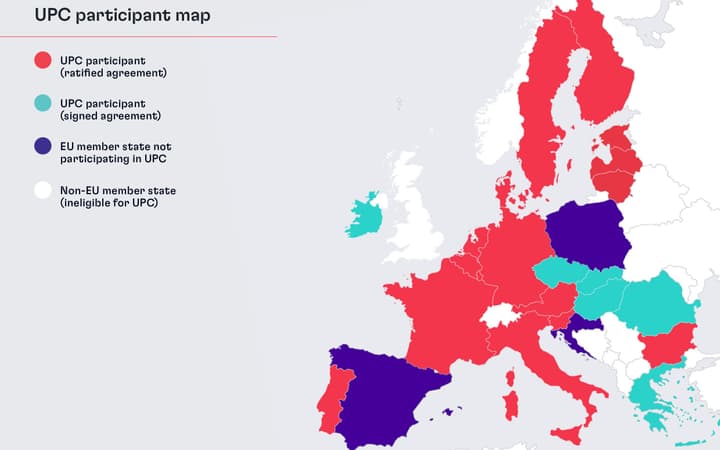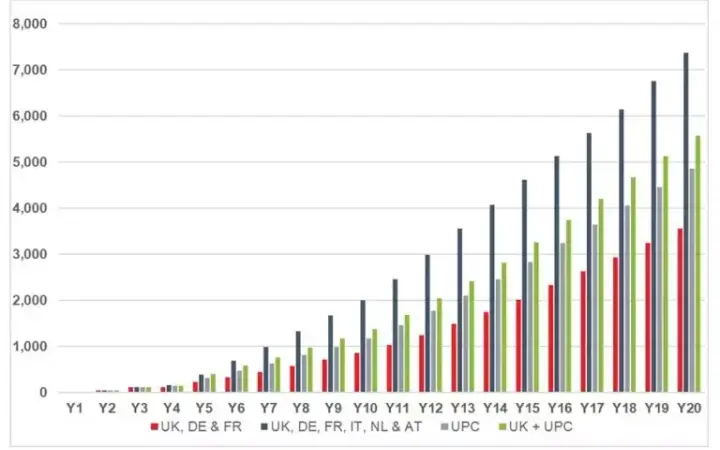A guide to the Unitary Patent & Unified Patent Court
Catherine Bonner, Donnacha Curley, Simone Giacobbe, Marina Mauro

The Unitary Patent and Unified Patent Court (UPC) are now both in operation, as of June 1 2023.
Here, you’ll find all you need to know including FAQs and insights.
Our global office network spans four continents, including Europe, where we have offices in the UK, France, Ireland, Finland, Germany, Italy and Switzerland. As we offer direct representation in 15 EU member states, our IP experts are well placed to answer your unitary patent questions.
If you have any questions at all about the UPC and what this means for your IP — speak to your usual advisor or our dedicated unitary patent team at unitarypatent@murgitroyd.com.
FAQs: Unitary Patent & Unified Patent Court
The following are the most frequently asked questions about unitary patent implementation. Talk to our team at unitarypatent@murgitroyd.com to receive tailored advice for your business.
What is the unitary patent?
The unitary patent system provides a patent proprietor with uniform protection and equal effect in all participating member states of the unitary patent system (currently 17 of the 38 member states of the European Patent Convention (EPC), namely Austria, Belgium, Bulgaria, Denmark, Estonia, Finland, France, Germany, Italy, Latvia, Lithuania, Luxembourg, Malta, the Netherlands, Portugal, Slovenia, Sweden). For enforcement and validity, this unitary effect means that the UPC (Unified Patent Court) has jurisdiction, with rights being enforced, revoked or lapsing in respect of all participating EU participating member states of the unitary patent system via a single, centralised forum.
The unitary patent system builds on the EPC in that its pre-grant phase is unchanged from that of a ‘classic’ EP patent and this is administered by the European Patent Office (EPO) as normal, including opposition and appeal procedures. Within one month of the date of grant, an applicant selects the form of EP protection as being:
i) a ‘classic’ European patent wherein there is validation in individual national states
ii) a ‘unitary’ patent providing ‘unitary effect’
(iii) a hybrid option of both a ‘unitary’ patent and validation of individual national states not encompassed by the ‘unitary’ patent
If the applicant chooses to proceed with a ‘classic’ European patent post-grant, validation procedures are unchanged.
A ‘classic’ European patent is essentially a bundle of national rights which require separate renewal, enforcement and (in some cases) translation. If the classic patent is not opted out of the jurisdiction of the Unified Patent Court then it may come under the jurisdiction of the Unified Patent Court.
Contrastingly, as a transnational and singular right, the unitary patent has one renewal fee and is centrally enforced at a ‘Unified Patent Court’. In this way, it offers proprietors cost savings.
What is the Unified Patent Court?
Based in Paris and Munich, the Unified Patent Court (UPC) is an entirely new transnational court, which may eventually replace national courts in Europe on all questions concerning the infringement and validity of patents granted by the European Patent Office in participating EU member states. This includes both unitary patents and ‘classic’ European patents which have been validated in participating EU member states.
The UPC includes a Court of First Instance and a Court of Appeal, which has streamlined procedures and judges with legal and technical specialisms. All of this is expected to make the EU a more attractive proposition to innovative businesses and increase its global economic competitiveness.
Who are the participating member states?
There are 38 Contracting States to the EPC available as classic EP patents, including both EU and non-EU countries.

Currently, 24 of the 27 Member States of the European Union have signed-up to the unitary patent system. However, of these, only 17 (Austria, Belgium, Bulgaria, Denmark, Estonia, Finland, France, Germany, Italy, Latvia, Lithuania, Luxembourg, Malta, the Netherlands, Portugal, Slovenia and Sweden) are currently available under the unitary patent system, with others expected to follow.
The remaining 21 EPC states can still be validated as ‘classic’ EP patents (including Ireland, Norway, Spain, Switzerland, Turkey and the UK).
This means that patent owners may now use a combination of these two patent types — ‘classic’ and ‘unitary’.
Can I opt out of the Unified Patent Court’s jurisdiction?
The creation of the UPC paves the way for a significant change to the patent litigation landscape — the UPC deals with infringement and validity issues for both UPs and EPs in all ratified EU Member States.
For an initial ‘transition period’ of seven years (which may be extended), it is possible to remove a patent granted by the EPO from the jurisdiction of the UPC by registering an opt-out at the UPC Registry at any time, prior to the commencement of litigation. This is a simple process with no official fees.
If opted out, provided no infringement or validity actions have been raised in relation to the patent rights, litigants have a choice of either using the national courts or withdrawing the opt-out (in effect opting in), in order to restore the shared jurisdiction of the UPC for validated EPs.
It is only possible to file an opt-in once. It is not possible to file a second opt-out.
By opting out, infringement and validity issues continue to be decided by the national courts. Opt-outs must be registered with the Unified Patent Court — not the EPO — for each granted European patent. The Unified Patent Court maintains a register of opt outs.
If an opt-out is not registered, any patent validated from a granted European Patent in a participating EU member state where the UPC is ratified may be considered under the UPC jurisdiction. Third parties may therefore challenge the validity of your patent rights before the UPC, locking you into the new procedures.
When can I benefit from a unitary patent?
Only European patents granted on or after 1 June 2023 are eligible for unitary effect. Now that the UPC is in force, applicants can file a request for unitary effect at the EPO within one month of European patent grant publication. This to benefit from the advantages of unitary patent: centralised administration, single renewal fee, unitary effect of infringement and revocation, etc.
How will renewals be affected by the unitary patent?
Renewal fees for unitary patents may be less expensive than for a ‘classic’ EP patent validated national patent rights renewal (if more than four national rights exist). Maintaining a unitary patent requires only one renewal fee paid to the EPO.

In summary:
- The unitary patent renewal fee will be approximately equivalent to the fees that had to be paid for four countries under the ‘classic’ EP system.
- The single annual fee will be ~€5k (cumulative) for the first ten years (of the 20-year term).
- Total fees for maintaining a unitary patent over the full 20-year term could be ~€35k. When compared to the total fees for maintaining a classic EP validated in DE, FR, NL and IT, this is a potential saving of ~€1.7k.
Further significant cost advantages may arise in any post-grant assignments, which can be recorded centrally in the register of unitary patents administered by the EPO, rather than separately in each national register.
Where the UK is validated, UK patent renewal costs must also be accounted for, due to the UK no longer being an EU territory.
How are pending European patent applications affected by the unitary patent?
The unitary patent is a post-grant procedure, so pending applications are not affected.
How will patent translations be affected by the unitary patent?
Translation of patents granted into English into an EU language will be required during an initial six-year transitional period, as will translation of a patent granted in either French or German into English. Any such translation will be for information purposes only, to reduce the risk of errors impacting protection. After the transition period has ended, the translation of granted unitary patents will not be required, except in litigation cases. This will greatly reduce costs for patent owners.
What do I need to do?
We recommend that you speak to our experts so that we can help you form a plan best suited to your individual needs.
From 1 June 2023, the default conditions upon the grant of an EP patent are:
- The granted patent is under the jurisdiction of the UPC. An opt-out may be requested at any time prior to litigation starting (while the ‘transitional’ provisions are in force). Any enforcement and revocation would then proceed exclusively at the individual national courts and the UPC would have no jurisdiction.
- The granted patent must be validated. Validation may be undertaken as:
i) a classic EP patent validation in national states, ii) a patent with unitary effect may be specifically requested,
iii) a combination of these validation strategies may be used.If a patent with unitary effect is requested, any unitary patent obtained falls under the exclusive jurisdiction of the UPC.
The following questions might help to guide you
- Are you comfortable with the potential for centralised revocation of an important patent?
If a particular patent provides significant commercial value, centralised revocation in all 17 states could be a significant concern. If so, then opting out of the UPC is probably suitable.
- Does your patent protection need to extend beyond four EU states?
If you require filing in four or more states and minimising cost is your priority, a unitary patent might be the better option. If not, then the ‘classic’ system of separate validations may be more cost effective.
- If your patent is jointly owned, can you reach an agreement among all proprietors on whether to proceed with unitary effect?
Requesting unitary effect (or opting out) requires all proprietors, as currently entitled to be recorded on the EPO register, to sign the request. As such, there must be agreement to proceed. If agreement cannot be reached, the patent will proceed with the above default provisions.
- Is it likely that you will transfer or license your EP patent, or change the company name or address?
If so, the centralised administration of a unitary patent may be the better option dependent upon your validation strategy.
- Are you concerned that the UPC has no existing case law?
If so, it may be wise to consider opting out. This will prevent your patent from being drawn into the UPC via a third party filing a central revocation action.






